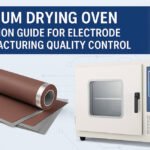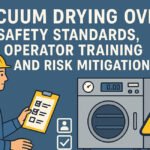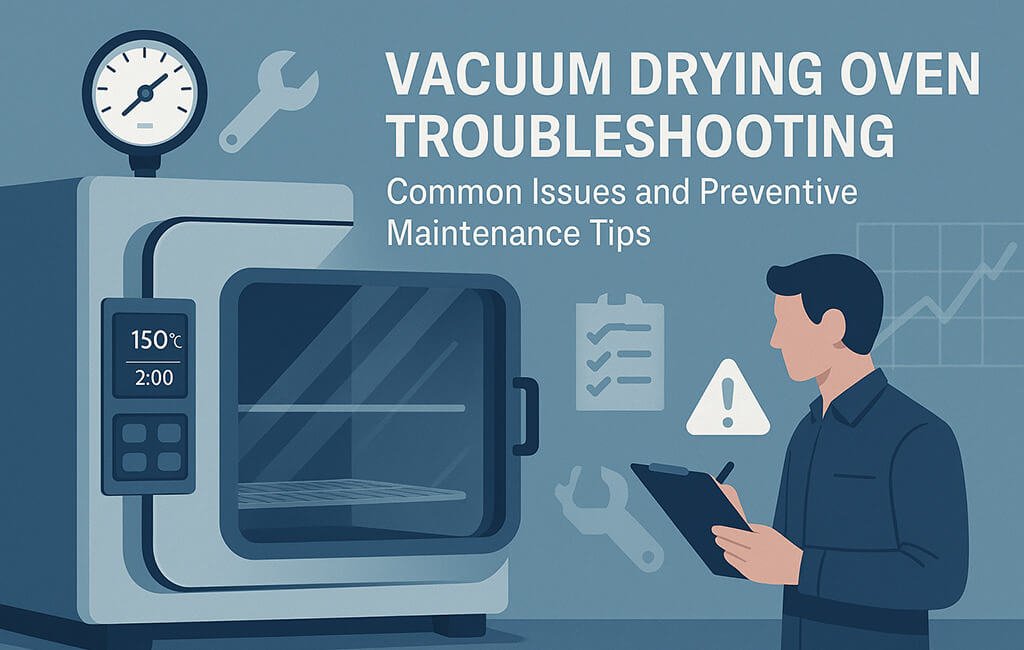Vacuum drying ovens play a critical role in battery electrode manufacturing. They remove residual solvents and moisture to meet stringent quality requirements for lithium-ion battery production. These systems must maintain precise temperature uniformity, vacuum levels, and drying profiles to ensure electrode coating integrity.
This comprehensive guide addresses common troubleshooting scenarios in vacuum drying oven operations. It includes preventive maintenance strategies tailored for battery manufacturing environments. Proper maintenance and systematic troubleshooting are essential for maintaining production efficiency and product quality.
What Are the Most Common Vacuum Drying Oven Failures in Battery Production?
The most frequent failures include vacuum leaks causing inadequate pressure levels and temperature non-uniformity affecting coating quality. Additional issues involve pump oil contamination, seal degradation from solvent exposure, and control system errors. These problems directly impact electrode moisture content and coating adhesion strength.
Early detection through systematic monitoring prevents costly production delays and quality defects. Understanding failure patterns specific to battery materials helps operators implement targeted preventive measures.
Vacuum System Failures
Vacuum system integrity is paramount for achieving low moisture levels in battery electrodes. Common vacuum-related failures include inability to reach target pressure, extended pump-down times, or pressure instability. These issues significantly impact production efficiency.
Primary causes include deteriorated door seals, compromised valve seats, and pump oil degradation. Leaks in vacuum lines or fittings also contribute to system failures. Each component requires specific diagnostic approaches based on exposure to battery material solvents.
Temperature Control Issues
Temperature uniformity directly affects coating quality and drying efficiency. Deviations can cause coating delamination, incomplete solvent removal, or thermal stress. These defects compromise electrode performance.
Common temperature-related problems include thermocouple drift and heating element degradation. PID controller tuning issues and heat distribution imbalances also affect uniformity. Multi-zone systems require additional attention to maintain consistent temperatures across all zones.
Systematic Troubleshooting Procedures
Effective troubleshooting follows a structured approach combining diagnostic measurements and visual inspections. This methodology minimizes downtime while ensuring accurate problem identification. Systematic elimination of potential causes leads to faster resolution.
Vacuum Leak Detection Methods
Systematic leak detection begins with isolation testing of individual chamber sections. The rate-of-rise method quantifies leak rates by isolating the chamber and monitoring pressure increase. This provides initial assessment of system integrity.
For precise leak location, helium leak detection offers the highest sensitivity. Spray testing with helium while monitoring mass spectrometer readings pinpoints specific leak locations. Document all findings for trend analysis.
| Leak Detection Method | Sensitivity Range | Application | Battery Production Considerations |
|---|---|---|---|
| Rate of Rise | 10⁻³ mbar·L/s | Initial screening | Quick assessment between production runs |
| Helium Mass Spec | 10⁻⁹ mbar·L/s | Precise location | Essential for <100 ppm moisture targets |
| Bubble Testing | 10⁻⁴ mbar·L/s | Gross leaks | Initial commissioning only |
| Pressure Decay | 10⁻² mbar·L/s | System validation | Daily production checks |
Temperature Uniformity Diagnostics
Temperature mapping reveals hot spots, cold zones, and overall uniformity patterns. Use multiple calibrated thermocouples at critical locations including corners and center points. Position sensors at typical product placement areas for accurate assessment.
Document temperature profiles under various loading conditions representative of production scenarios. Compare results against specifications for electrode drying. Most applications require ±3°C uniformity for optimal coating quality.
Control System Troubleshooting
Modern vacuum drying ovens utilize PLC-based control systems with multiple sensors and actuators. Systematic troubleshooting begins with error code analysis and sensor validation. This approach quickly identifies control-related issues.
Common control problems include sensor calibration drift and communication errors between components. Solid-state relay failures also disrupt system operation. Maintain a comprehensive error code reference specific to your equipment model.
How Often Should Vacuum Drying Oven Components Be Maintained?
Maintenance frequency depends on production volume, material types, and operating conditions. High-volume battery production with NMP-based processes requires more frequent maintenance than water-based systems. Critical components need regular attention to prevent failures.
Vacuum pumps require oil changes every 1000-2000 operating hours for optimal performance. Door seals need monthly inspection and annual replacement. These intervals ensure reliable operation and consistent drying quality.
| Component | Inspection Frequency | Replacement Interval | Critical Parameters |
|---|---|---|---|
| Door Seals | Monthly | 12-18 months | Compression set <25% |
| Vacuum Pump Oil | Weekly | 1000-2000 hours | Viscosity, contamination level |
| Thermocouples | Quarterly | 24-36 months | ±1°C accuracy |
| HEPA Filters | Monthly | 6-12 months | Pressure drop <250 Pa |
| Valve Seats | Quarterly | 18-24 months | Leak rate <10⁻⁴ mbar·L/s |
| Heating Elements | Semi-annually | 36-48 months | Resistance ±10% nominal |
Preventive Maintenance Best Practices
A comprehensive preventive maintenance program significantly reduces unplanned downtime. It maintains consistent drying quality for battery electrodes. Focus on critical systems that directly impact product quality and safety.
Vacuum Pump Maintenance
Vacuum pumps represent the heart of the drying system. Regular oil analysis detects contamination before pump damage occurs. Monitor oil color, viscosity, and contamination levels weekly to ensure optimal performance.
Establish proper pump startup and shutdown sequences to prevent oil backstreaming. Ensure adequate pump warmup before exposing to full vacuum load. This is particularly critical when processing NMP-containing materials.
Seal Inspection and Replacement
Door seals experience continuous compression cycles and chemical exposure from battery solvents. Monthly inspections should check for compression set, cracking, hardening, or swelling. These signs indicate seal degradation requiring attention.
Use fluororubber (FKM) seals for NMP resistance and silicone for water-based processes. Maintain spare seal inventory based on lead times and production needs. Document installation dates and track performance metrics for predictive replacement.
Temperature Calibration Procedures
Thermocouple accuracy directly impacts drying quality and energy efficiency. Implement quarterly calibration using certified reference standards. All calibrations must be traceable to national standards for quality assurance.
Perform in-situ calibration when possible to account for installation effects. Document results and trend drift patterns to predict replacement timing. Replace thermocouples showing drift beyond ±2°C to maintain process control.
Battery-Specific Drying Parameters and Troubleshooting
Battery electrode drying requires precise control of temperature, vacuum level, and residence time. These parameters ensure target moisture levels while preserving coating integrity. Understanding material-specific requirements enables optimized troubleshooting approaches.
Moisture Specification Requirements
Battery-grade electrodes typically require moisture levels below 500 ppm. Some applications demand less than 100 ppm for optimal performance. Achieving these levels requires proper vacuum, temperature profiles, and residence times.
Monitor moisture content using Karl Fischer titration or specialized inline sensors. Correlate moisture levels with drying parameters to establish process windows. This data helps optimize drying for different electrode configurations.
NMP Solvent Drying Considerations
N-Methyl-2-pyrrolidone (NMP) in cathode coatings requires specific drying profiles. Excessive temperature or heating rates cause binder migration. Insufficient drying leaves residual solvent that affects cell performance.
Typical NMP drying operates at 120-150°C under vacuum levels of 10-50 mbar. Multi-zone temperature profiles optimize solvent removal while maintaining adhesion. Monitor exhaust solvent concentration to verify complete removal.
Coating Defect Prevention
Common coating defects during vacuum drying include blistering, delamination, and cracking. These issues often trace to improper temperature ramping or inadequate vacuum levels. Contamination in the drying atmosphere also causes defects.
Implement controlled heating rates of 2-5°C/minute to prevent rapid solvent evaporation. Maintain consistent vacuum levels throughout the drying cycle. This ensures uniform solvent removal across the electrode surface.
What Safety Protocols Are Essential for Vacuum Drying Oven Operation?
Safety protocols must address fire hazards from flammable solvents and explosion risks from lithium compounds. Essential measures include grounding verification, emergency shutdown procedures, and atmospheric monitoring. Lockout/tagout protocols during maintenance prevent accidents.
Electrical Safety and Grounding
Verify grounding integrity monthly using earth resistance testing. Proper grounding prevents static discharge that could ignite vapors. It also protects sensitive battery materials from electrical damage.
Install ground fault circuit interrupters (GFCI) on all power circuits. Test GFCI functionality monthly and document results. Ensure all conductive parts maintain electrical continuity to ground.
Solvent Vapor Management
Battery electrode drying releases significant solvent vapors requiring proper ventilation. Install LEL sensors for flammable vapor detection with alarms at 10% LEL. This provides early warning of dangerous conditions.
Maintain exhaust system functionality through regular inspection of components. Verify capture velocity at emission points meets safety standards. Proper ventilation prevents vapor accumulation and ensures operator safety.
Emergency Response Procedures
Establish clear emergency shutdown procedures accessible to all operators. Include steps for safe vacuum release and heating element shutdown. Material isolation procedures prevent contamination during emergencies.
Conduct monthly emergency drills covering various failure scenarios. Practice responses to vacuum loss, overtemperature conditions, and vapor alarms. Maintain accessible spill kits and fire suppression equipment for lithium materials.
Troubleshooting Checklist for Common Issues
This systematic checklist guides operators through diagnostic steps for frequent problems. Follow these procedures to quickly identify and resolve vacuum drying oven issues:
- Unable to Achieve Target Vacuum:
- Check door seal compression and alignment
- Verify pump oil level and condition
- Test vacuum gauge calibration
- Perform leak check on all penetrations
- Inspect valve seats for damage
- Temperature Non-uniformity:
- Verify all heating zones operational
- Check thermocouple readings against reference
- Inspect insulation integrity
- Review PID tuning parameters
- Confirm proper air circulation patterns
- Extended Drying Times:
- Verify vacuum level stability
- Check heating element functionality
- Confirm proper loading configuration
- Review temperature setpoint accuracy
- Inspect for air leaks increasing heat load
- Control System Errors:
- Document specific error codes
- Check sensor connections and readings
- Verify PLC program integrity
- Test communication links
- Review recent parameter changes
Spare Parts Management
Maintaining appropriate spare parts inventory prevents extended downtime during critical periods. Focus on components with long lead times or high failure rates. Strategic inventory management balances cost with availability.
Critical Spare Parts List
Essential spares include door seals, vacuum gauges, thermocouples, and pump repair kits. Control system components should also be stocked based on failure history. Base inventory levels on lead times and production criticality.
Partner with equipment manufacturers to establish consignment programs for expensive components. This includes vacuum pumps and heating elements. Consignment programs balance inventory costs with immediate availability needs.
Storage and Handling Requirements
Proper storage extends spare part shelf life and ensures reliability. Store rubber seals in cool, dark conditions away from ozone. Maintain electronic components in anti-static packaging with humidity control.
Implement first-in-first-out rotation for components with limited shelf life. Document storage conditions and inspection dates. This prevents installing degraded parts that could cause premature failures.
Conclusion
Effective troubleshooting and preventive maintenance require understanding equipment principles and battery-specific requirements. Systematic diagnostic procedures and comprehensive maintenance schedules ensure reliable operation. Focus on critical parameters affecting electrode quality for optimal results.
Proactive maintenance, thorough documentation, and advanced troubleshooting techniques maximize equipment reliability. These practices ensure vacuum drying ovens deliver precise moisture control and coating integrity. Regular training and continuous improvement further enhance equipment performance and product quality.
Glossary
- Vacuum Level:
- The degree of pressure reduction below atmospheric pressure, typically measured in mbar or Torr, critical for achieving low moisture content in battery electrodes.
- NMP (N-Methyl-2-pyrrolidone):
- A polar aprotic solvent commonly used in cathode slurry formulations, requiring specific drying parameters to ensure complete removal.
- Outgassing:
- The release of trapped gases or vapors from materials under vacuum conditions, affecting ultimate vacuum levels and drying efficiency.
- PID Controller:
- Proportional-Integral-Derivative control system that maintains temperature stability by continuously adjusting heating output based on setpoint deviation.
- Compression Set:
- Permanent deformation of sealing materials under sustained compression, indicating seal degradation and replacement need.
- LEL (Lower Explosive Limit):
- The minimum concentration of flammable vapor in air capable of ignition, monitored for safety during solvent drying operations.
- Karl Fischer Titration:
- Analytical method for precise moisture content determination in battery materials, essential for quality control verification.
- Rate of Rise:
- Vacuum leak detection method measuring pressure increase over time in an isolated chamber to quantify total system leak rate.



